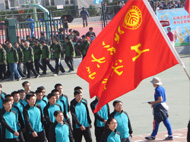题目:Processing and Modeling of a Porous Medium in the Design of Solid Oxide Electrolyzer Cells
报告人: Professor H. Garmestani
School of Materials Science and Engineering, Georgia Institute of Technology,
Atlanta, GA, 30332-0245 USA.
主持人:郑玉峰 教授
时 间:6月10日(周二)下午16:00
地 点:力学楼434会议室
报告内容摘要:
Cost effective manufacturing of cathodes with a porous structure to allow rapid mass transport of reactant and product gases is one of the major challenges in manufacturing large area solid oxide fuel cells (SOFCs). In this project, spray pyrolysis is investigated as a method for deposition of porous LSM layer onpressed YSZ electrolyte substrate. The ideal goal is manufacturing a porous LSM cathode layer which has a gradient in its structure-which is fine close to the surface of electrolyte and is coarse, forming massive columnar pores in outer layer. A methodology for microstructure design of the resultant fuel cell materials is developed using statistical continuum mechanics theory to link mechanical, magnetic, and transport properties to microstructures representation. Effective properties for the transport and mechanical properties were calculated. The information for microstructure is used in a general framework for microstructure design to optimize the process parameters of the fuel cell microstructure.
欢迎广大老师和研究生参加!
报告人简介:BIOGRAPHICAL SKETCH OF PROFESSOR H. Garmestani
Prof. Hamid Garmestani, faculty since 1991, is a Professor of Materials Science and Engineering at Georgia Institute of Technology. He received his Ph.D. from Cornell University in 1989 and spent two years as a post-doctoral fellow at Yale University. He worked an assistant Professor at Florida State University until he joined Georgia Institute of Technology in 2003. He is primarily known for his work on characterization and modeling using statistical mechanicsapproaches and Microstructure Sensitive Design of fuel cell porous structures, magnetic inductors and nanocomposites. He has been involved high temperature magnetic annealing that has been used as a new process for texturing of magnetic (and non-magnetic) materials and the production of highly oriented nano-magnets. His theoretical models on statistical mechanics using higher order correlation functions has shown a drastic improvement is the prediction of materials behavior compared to other homogenization relations. Such theoretical models have also been used to predict microstructure and correlation to processing path in a microstructure sensitive design framework for several processing paths including magnetic heat treatment, superplasticity, cross-rolling, and Chemical Vapor Deposition (CVD. He has developed techniques to acquire the statistical information from scattering and diffraction techniques based on x-ray and microscopy (Electron Backscattered Diffraction Techniques) with special attention was given to in-situ characterization of materials.
Dr. Garmestani is a member of the editorial board of the Journal Engineering Materials and Technology, International Journal of Plasticity. He has published more 200 papers (120 as refereed journal publications).









